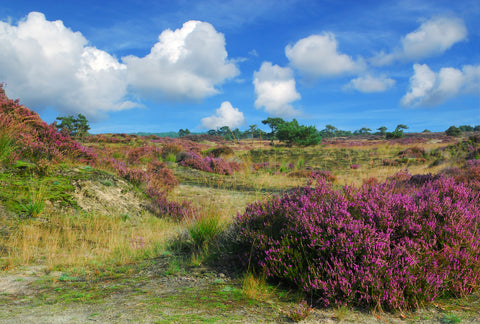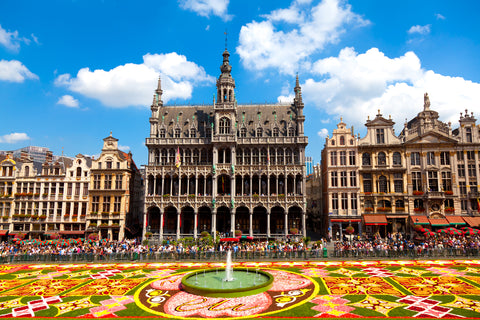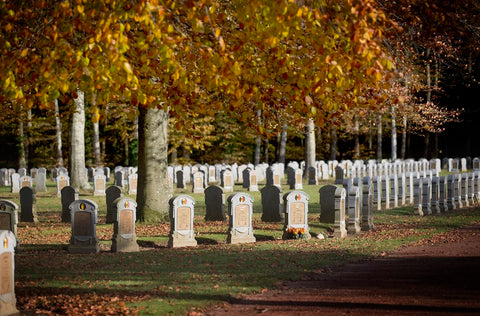- No products in the cart.
History
The region that is now Belgium has been populated for more than 100,000 years, Eastern Belgium is even the world's first and richest finding place for Neanderthal remains. Along the way it has passed through the ownership of almost all the major continental European powers.
From the Roman period to the arrival of the Vikings it’s pretty hard to find a people who didn’t invade and plunder the country.
Although it’s a complicated story, certainly when it comes to the nation’s current political structure, Belgium has a rich and interesting history which we’ll try and sum up here.
How did Belgium and its people get here, what was the region's role before it became independent? It’s a relatively young and always evolving modern (European) nation, considered artificial by some but very real to others... This is more than 2,000 years of history in a very small nutshell.
Archaeological artifacts dating back as far as prehistoric times are on display at the Cinquantenaire Museum in Brussels.
Moving In

The Belgae, one of the many early Celtic tribes who settled in the Low Countries during prehistoric times, give their name to the land that would be called Belgium from 1830 onwards. In 52 BC these ferocious tribes were conquered and all but eradicated by Julius Caesar and his Roman army after almost five years of heavy fighting.
In Caesar’s De Bello Galico (I & I) appears the following, historical thought: “Of all tribes in Gaul, the Belgae are the bravest”. This could, however, just mean that Caesar needed some justification for why he took so long to defeat his barbarian foes.
Later on, as the Roman Empire declined, the Germanic Franks moved into the Belgian region from the east, settling mainly in the north and west of what is now Belgium and bringing the Germanic language which would eventually become Flemish.
Belgium has been a bilingual country from the very start. France, Britain and Spain were by this period more or less as they are now, but in the middle ages much of Europe was made up of an large number of countries and territories, some of which were little more than big villages.
It was quite common for the leadership of these small packages of land to change hands as part of marriage settlements or as a result of conquest; the wishes of the local inhabitants were the last concern of those who ruled over them.
There is a very eloborate Gallo Roman Museum dedicated to this period in history located in the city of Tongeren, Limburg.
The Middle Ages

In the middle ages, the Belgian region was divided into two parts: there was the Flemish speaking county of Flanders and the Flemish and French speaking duchies of Hainaut – Brabant which then belonged to the Holy Roman Empire. The region’s linguistic boundaries could scarcely have been more confused.
In 1214 King Philip II of France defeated the Count of Flanders in war and annexed his territory. The people of Flanders weren’t too keen on the idea of being under French rule and continued to put up a fight.
At the Battle of Kortrijk on 11th July 1302 heavily armed Flemish troops, many of humble origin, triumphed over the French in a victory which is still marked with a public holiday today. It all started with a revolt in Bruges in which large numbers of French were killed.
The French king, Phillip IV, sent an army under Robert Count of Artois to subdue this upstart Flemish peasant army. For the cream of French chivalry this should have been a mere trifle, their mounted aristocratic knights were considered – not least by themselves - invincible. However, they were to suffer a resounding and humiliating defeat.
The Flemish, fighting for their nation, took no prisoners and massacred the French knights. Their golden spurs were collected from the battlefield and for the next 80 years they were displayed in the Church of Our Lady in Kortrijk. As a result the battle was named the Battle of the Golden Spurs.
A Burgundian Lifestyle

Sadly, this remarkable feat did not put an end to the French occupation of Flanders. Despite continued clashes Flanders remained in French control until the start of the Hundred Years War in 1337.
In 1433, most of these small feudal states were acquired by the dukes of Burgundy and for a period of almost a hundred years they managed to hold this buffer zone squeezed between France and Germany.
At first, the region found itself in a difficult position, because while politically subservient to France, it relied on France’s great enemy England for trade. As a result, many of the, highly skilled, Flemish craftsmen migrated to England, taking with them the science that had made Flemish cloth such a highly valued product.
Gradually the Low Countries developed into an important commercial and trading centre with merchants rising to become the dominant class of the towns while the nobility stayed on their country estates.
The Flemish counties prospered and it’s probably from this period that Belgians inherit their love of fine food and drinks. Even today Belgians are referred to as followers of an opulent Burgundian lifestyle.
Most of Belgium and Luxembourg, along with much of the rest of the Low Countries were incorporated into Burgundy by Duke Phillip the Good. This was a period of artistic and cultural achievement as well as booming trade, commerce and craft, with towns such as Ypres, Ghent, Bruges, Brussels and Antwerp becoming major cities.
The Spanish & Austrian Netherlands

The Duchy of Burgundy was a rich prize for the newly powerful nation states, and after the heirless death of the last duke, Charles the Bold. In 1477 many of his territories were taken by the French crown while his daughter’s hand was snapped up by the Hapsburg family, branches of which ruled both Spain and Austria.
In November 1700, the Spanish king died without a direct heir and two men vied for the inheritance, which included the Spanish Netherlands (or modern day Belgium, Luxemburg and Holland): the French Philip of Anjou and Archduke Charles from Austria.
After the passing of the Spanish monarch both England and Holland immediately made it clear that they would tolerate neither a possible union between Spain and France nor one between Spain and Austria.
The result became known in history as the War of Spanish Succession, which was mostly fought on Belgian Soil before the Treaty of Utrecht on 11 th of April 1713 finally brought hostilities to an end.
Philippe of Anjou was still recognised as king of Spain, but the Spanish Netherlands and most of the lands under the rule of Spain were given to the Austrian Hapsburgs. Belgium was now known as the Austrian Netherlands.
Becoming Belgium
.jpg?1356705390)
In 1568, portions of the Low Countries – the 17 provinces - revolted against their Spanish rulers, beginning the Eighty Years War. For the Southern Netherlands the fall of Antwerp in 1585 brought an end to the conflict and it’s from that time that we start to see Belgium as a single region.
The Northern Low Countries, now the Netherlands, seized independence and immediately embarked on what history calls the Dutch Golden Age.
In what we now know as modern day Belgium, times were not so good, with a cycle of revolution and oppression which eventually ended with the Brabant Revolution of 1789.
The loss of Flanders and the rest of their Belgian territories a few centuries earlier had not gone down well with the French, and when the opportunity came to get them back, they leaped at the chance.
In 1794 the Austrian Netherlands were invaded and annexed the following year, finally bringing an end to Habsburg rule. The country was divided into departments and became an integral part of France.
Not for long though, because the Congress of Vienna that ended the Napoleonic wars in 1815 decided to add the nine provinces of Belgium to the Netherlands in order to form a strong buffer state to the north of France.
Also included in the package were small states such as the Prince-Bishopric of Liège that had previously been independent.
The resolution couldn’t have been more disastrous: all the religious, political, economic and cultural differences between the northern and southern provinces were going to be an enormous source of conflict.
New Boss, New Rules

The Dutch King William I of Orange ruled the new country. William was a Protestant whose Calvinistic beliefs made him very intolerant of the Catholic majority. He guaranteed equal protection for every religious creed, but this overthrew the old established Catholic order of things.
During William’s rule the whole country prospered as industrialisation spread to the south, with new textile industries powered by local coalmines. In the north, after many years of disruption, a profitable trade was resumed once more.
Then came the crisis. Religion and language have always had a profound influence on the Belgian people and by 1830 the crisis had come to a head. Only a quarter of the population of the Kingdom were Protestant and most of these lived in the north of the country.
Most of the 3½ million South-Netherlanders were Catholic and although in theory they had full equality with the Protestants, they resented the fact that the government was overwhelmingly Protestant in both outlook and leadership.
Catholics were in the minority in all major areas of authority. The king was undoubtedly highly insensitive towards the Catholics. For instance he insisted that schools in the South should end traditional teaching of Catholic doctrine, even though everyone there was Catholic. He also insisted that Dutch should become the language of Government, which particularly angered the French-speaking Walloon majority.
The Final Revolt

As industrialisation grew and the South began to be more prosperous than the North, there was resentment at the continuing arrogance and political domination of the Protestant, Dutch-speaking Northerners.
When it was suggested that a French-language teacher-training college be opened in Liège, the King flatly vetoed the proposal. This simply fuelled the growing resentment. The revolution finally broke out in Brussels in August 1830.
There was a performance of Auber’s La Muette de Portici at the Brussels Opera House and the audience were so stirred by the Revolution Scene that they spilled out onto the streets singing patriotic songs.
Rioting broke out and the situation was soon out of control. The King assumed that everything would soon die down and he waited for the revolutionaries to surrender.
When they didn’t back down, the King sent in the army. The army met with fierce resistance and after three days of street fighting they were ordered out of the capital. Unrest was not only limited to Brussels. In Antwerp, after the revolutionaries had taken the city, eight Dutch warships were bombarded.
The war with the Netherlands lasted for eight more years, but in 1839 the Treaty of London was signed.
As a result of the Treaty, Belgium lost Eastern Limburg and Zeeuws Flanders, which went to the Netherlands.
French Flanders, which had be annexed during the time of Louis XIV, was returned to France and German-speaking Eupen transferred to the German Confederation, although it was later to return to Belgium after World War I in reparations. These four territories had all been claimed by Belgium on historical grounds.
King, Country & Constitution

After Belgium declared its independence from the Netherlands in 1830. Leopold Prince Von Sachsenburg-Coburg Und Gotha, an uncle of Queen Victoria, took the oath as the first king in 1831. Leopold had been on the verge of becoming the new king of Greece before this vacancy popped up.
Belgium’s sovereignty and neutrality were guaranteed by all of the European powers, thanks in part to the new king’s excellent family connections. Belgium became a parliamentary, democratic, constitutional monarchy.
The new born state set out on its national journey with a voting system based on a tax qualification.
This gave political and economic power to the mainly French-speaking, upper-middle class, who were split into two ideological camps: conservative Roman Catholics on the one hand, and the progressive, freethinking Liberals on the other. The constitution of 1831 stipulated a separation of Church and the State which made Belgium one of the first secular, pluralist and liberal nations of the world.
God was never mentioned in the Constitution, not even as a supporting-act. No wonder there was plenty of competition between the left and the right in this open political field - though the country tended towards the right until the start of World War I.
It was only at the end of the 19th century, as industrialisation led to universal suffrage, that the Socialist Party appeared on the scene. However, it soon found its place as the nation’s second political force, displacing the Liberal Party.
A Taste For Africa

Around the same time, the Congo was being explored by the Welsh-American Sir Henry Morton Stanley, under the auspices of Belgium’s King Leopold II. This ambitious ruler desperately wanted to expand his empire with a colony. After a futile attempt to buy the Philippines from Spain he established personal rule over Congo Free State in 1885 and annexed it (under heavy international pressure) to Belgium in 1908.
At first the exploitation of the colony proved to be a financial disaster for the king. Trade in ivory and mainly rubber finally generated him an enormous personal fortune. Once annexed, the Congo proved to be of huge importance to the Belgian state and its economic, financial and military development.
The country dwarfed Belgium in size and gave it almost unlimited access to vast natural resources like cocoa, timber, copper, diamonds and other valuable minerals. During World War II , Congo even provided the US with the uranium needed to fuel the Manhattan-project and construct the atomic bombs that would destroy Hiroshima and Nagasaki.
From the start of colonial rule, stories of Belgian colonists abusing and maltreating the local tribes were, sadly, frequently reported. The most well-known account of this tragic story is in the great novel “Heart of Darkness” (1902) by Joseph Conrad.
The Belgian presence disrupted the traditional life of the Congolese in almost every way possible. Over a period of 12 years – depending on the source - the population decreased by between eight and 30 million people. Over time, the cry for self-government grew louder and the people of Congo finally started to revolt.
The Belgians eventually fled the country under military protection and in 1960 the Republic of Congo obtained its independence. King Leopold II died in 1908 never having set foot on Congolese soil…
King Baudouin would become the last Belgian monarch to officially visit the colony once personally owned by his great-grandfather. Today, the Belgian government actively supports the Democratic Republic of Congo in its development.
The beautiful Royal Museum for Central Africa is in Tervuren, Brussels and is well worth the visit as it has the biggest and finest collection of Central African artifacts in the world.
The Spanish & Austrian Netherlands
Philippe of Anjou was still recognised as king of Spain, but the Spanish Netherlands and most of the lands under the rule of Spain were given to the Austrian Hapsburgs. Belgium was now known as the Austrian Netherlands.





